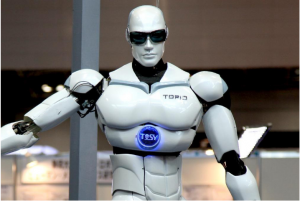Artificial Intelligence Can Transform Marketing
- At May 10, 2016
- By rbadmin
- In Blog
 0
0

Over at the Huffington Post, Emma Rush, CEO of the British marketing agency Chemistry, makes a solid case that the marketing industry can learn a lot from Netflix. “Its algorithms,” she writes, “are used to gauge the success of shows, target relevant creative, package programming for specific people, and even to acquire new programming.”
Netflix knows what you want to watch because it knows what you have already watched. The more movies and shows you watch on Netflix, the more the company “knows” you and the more data its algorithms can churn. If you tend to gravitate toward award-winning romantic comedies, Netflix will suggest, or push, award-winning romantic comedies you haven’t watched yet.
If you want to see an even better model, look at Amazon. It started out as a bookstore, but it now sells just about everything except real estate and cars. You can get the electronic edition of the latest Lee Child thriller, but you can also order bath towels, steak seasoning, a high-tech non-stick frying pan, incense from India, and nutritional supplements. You can also stream Amazon Studios’ original content, such as the terrific police procedural, Bosch, based on Michael Connelly’s novels about LAPD homicide detective, Hieronymus (Harry) Bosch, named after the famous Dutch painter.
Because you can buy, read and watch just about anything from Amazon, the website’s algorithms can collect even more data points about you than Netflix can. Some people find this creepy, to be sure, and don’t want to be tracked by faceless corporations on the Internet, but the truth is that most people like it when retailers know what they want in advance and therefore know how to market to them.
One of the big reasons why Barnes and Noble struggles so much to compete online with Amazon is because when you go to BarnesandNoble.com, the company doesn’t care all that much about what you want to read. It pushes the latest best-sellers instead. Shopping for books at Amazon is the online equivalent of stepping into a brick and mortar bookstore where the owner has known you personally for years and can confidently say, “hey, we’ve got this new book by a fantastic new unknown author, and I know you’re going to love it.”
Compare that to how most websites work. “Three quarters of people are frustrated with websites when ad content has nothing to do with their own interests,” Rush writes, “and as more of our online activity moves to mobile, advertising eating into users’ mobile data plans is likely to become an even more emotive issue.”
Amazon and Netflix are able to provide a deeply personalized experience because their artificially intelligent algorithms have massive amounts of personal data to work with. Few companies—and no marketing agencies—have that kind of data at their disposal right now. And no company or organization will ever know everything about an individual’s tastes and preferences. Privacy concerns aren’t going away. Corporate and government omniscience is naturally resisted by huge numbers of people and probably always will be.
It’s nevertheless likely that the massive amounts of time marketing strategists currently spend pouring over mind-boggling amounts of data will eventually be outsourced to intelligent algorithms like those used at Netflix and Amazon. Advertisers may never have as much data to work with, and human intelligence backed up by years of professional experience and judgment can probably never be replaced by a marketing robot, but artificial intelligence is still in its infancy. We’re at the very beginning of a trend here, not the end.
“Netflix data didn’t create Breaking Bad,” Rush concludes, “and there was no data that could have predicted such a storyline would work. That was down to the show’s creator Vince Gilligan and his desire to rewrite the traditional ‘rules’ of a TV series. What Netflix is very good at, and what brands can learn from, is how to set up systems overlaid with human creativity. Systems that identify, in real-time, the various ways people engage with programmes, allowing brands to make faster and more confident decisions about what to show, to whom, and when.”
